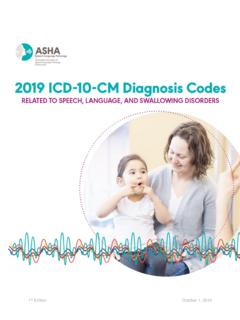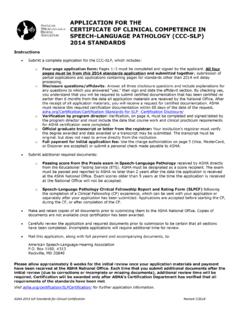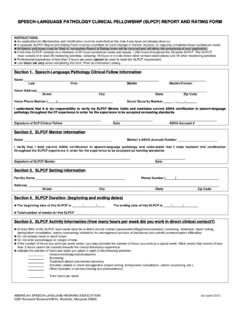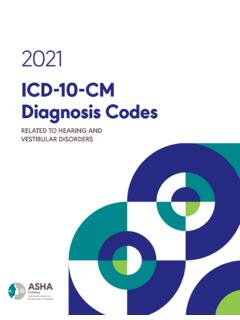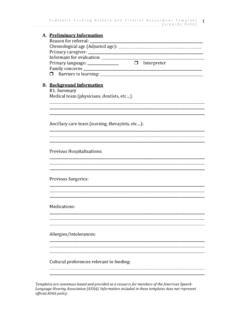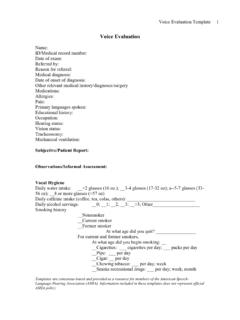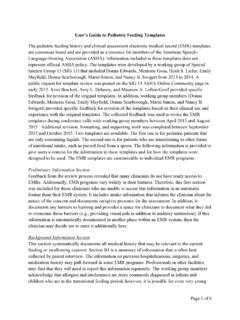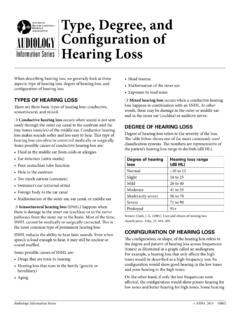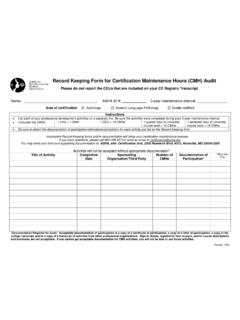Transcription of Understanding the Differences Between Auditory …
1 2200 RESEARCH BOULEVARD ROCKVILLE, MARYLAND 20850-3289 301-296-5700 VOICE OR TTY Understanding the Differences Between Auditory Processing, Speech and Language Disorders, and Reading Disorders October 2014 INTRODUCTION This document has been prepared to provide an overview of the Differences among Auditory processing disorders, communication disorders, and reading disorders to clarify the need for accommodations for students with communication and processing disorders. The document is organized by definition of the disorder, treatment options, and accommodations, followed by results of a study that differentiates Between reading and language disorders.
2 A 2011 Government Accountability Office (GAO) study recommended that the Department of Justice develop a systematic approach to ensuring that all eligible students receive accommodations. GAO further recommended that the decision to allow for accommodations be based on the individual s history and the recommendations of teachers and service providers and not on a single measure of performance. This document includes study highlights, a link to the full study, and specific examples of the impact that lack of accommodations has on individual student performance.
3 STUDENT ELIGIBILITY FOR SPECIAL EDUCATION Students are sometimes determined to be eligible for services based solely on their communication disorders. Once identified as eligible, these students have access to all necessary services and supports. Because they receive such supports and services, additional testing may not be performed and a subsequent reading disorder may not be revealed. Although not all students diagnosed with a communication disorder will develop a reading disorder, some may require accommodations to enable them to benefit from their education.
4 RECOMMENDATIONS Based on the results of the GAO study, the impact on student performance for those students denied accommodations, and the differentiation Between the needs of students with communication disorders and those with reading disorders, ASHA recommends that decisions about the need for accommodations be made by reviewing the student s history, the accommodations that have been provided to the student throughout his or her school years, and the recommendations of the student s educational team.
5 As noted above, no single criterion should be used to determine eligibility for testing accommodations, and rules for accommodations should be applied consistently across disability categories. DEFINITIONS Auditory Processing Disorder Auditory processing disorders (ADP) are deficits in the information processing of audible signals not attributed to impaired peripheral hearing sensitivity or intellectual impairment. This information processing involves perceptual, cognitive, and linguistic functions that, with appropriate interaction, result in effective receptive communication of auditorily presented stimuli.
6 Specifically, APD refers to limitations in the ongoing transmission, analysis, organization, transformation, elaboration, storage, retrieval, and use of information contained in audible 2 Key Points: APD is an Auditory disorder that is not the result of higher-order, more global deficit, such as autism, mental retardation, attention deficits, or similar impairments. Not all learning, language, and communication deficits are due to APD. No matter how many symptoms of APD a child has, only careful and accurate diagnosis can determine if APD is, indeed, present.
7 Although a multidisciplinary team approach is important in fully Understanding the cluster of problems associated with APD, the diagnosis of APD can only be made by an audiologist. Treatment of APD is highly individualized. There is no one treatment approach that is appropriate for all children with APD. signals. APD may involve the listener's active and passive ( , conscious and unconscious, mediated and unmediated, controlled and automatic) ability to do the following: attend, discriminate, and identify acoustic signals; transform and continuously transmit information through both the peripheral and central nervous systems; filter, sort, and combine information at appropriate perceptual and conceptual levels; store and retrieve information efficiently; restore, organize, and use retrieved information.
8 Segment and decode acoustic stimuli using phonological, semantic, syntactic, and pragmatic knowledge; and attach meaning to a stream of acoustic signals through use of linguistic and nonlinguistic contexts. Children with APD may exhibit a variety of listening and related complaints. They may have difficulty Understanding speech in noisy environments, following directions, and discriminating (or telling the difference Between ) similar-sounding speech sounds. Sometimes they may behave as if a hearing loss is present, often asking for repetition or clarification.
9 In school, children with APD may have difficulty with spelling, reading, and Understanding information presented verbally in the classroom. Often their performance in classes that don't rely heavily on listening is much better, and they typically are able to complete a task independently once they know what is expected of them. APD may co-exist with attention deficit hyperactivity disorder (ADHD) or other disorders. A multidisciplinary team approach is critical to fully assess and understand the cluster of problems exhibited by children with APD, but the actual diagnosis of APD is made by an audiologist, who administers a series of tests in a sound-treated room.
10 These tests require listeners to attend to a variety of signals and to respond to them via repetition, pushing a button, or in some other way. Other tests that measure the Auditory system's physiologic responses to sound may also be administered. Most of the tests for APD require that a child be at least 7 or 8 years of age, because the variability in brain function is so marked in younger children that test interpretation may not be possible. Treatment Treatment of APD generally focuses on three primary areas: changing the learning or communication environment, recruiting higher-order skills to help compensate for the disorder, and remediation of the Auditory deficit itself.
